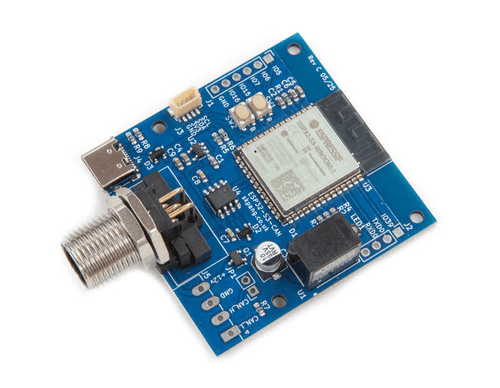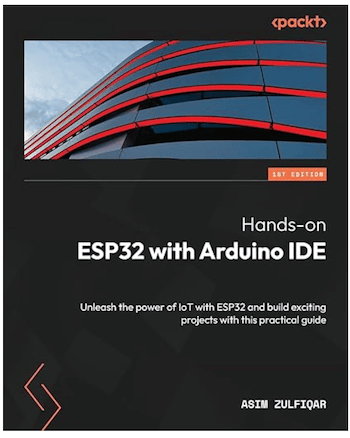Blog
Recent Posts
Unlock the Future of Marine Apps with the ESP32-S3 CAN Bus Board with NMEA 2000 Connector
Posted by on
 As the marine industry continues to embrace smart technologies, there's a growing demand for powerful, connected, and reliable embedded solutions that can handle everything from engine diagnostics to GPS data aggregation. Whether you're building a marine monitoring system, an onboard data logger, or an intelligent control unit, you need a development board that offers high performance, versatile connectivity, and robust CAN Bus communication.
As the marine industry continues to embrace smart technologies, there's a growing demand for powerful, connected, and reliable embedded solutions that can handle everything from engine diagnostics to GPS data aggregation. Whether you're building a marine monitoring system, an onboard data logger, or an intelligent control unit, you need a development board that offers high performance, versatile connectivity, and robust CAN Bus communication.
Introducing the ESP32-S3 CAN Bus Board with NMEA 2000 Connector, a compact and powerful solution offered by Copperhill Technologies to meet the rigorous demands of modern marine electronics and IoT applications.
Why the ESP32-S3?
At the heart of this development board lies the ESP32-S3-WROOM-1-N8R8 module, powered by a dual-core Xtensa® LX7 processor running at up to 240 MHz. With 8 MB of PSRAM and 8 MB of flash memory, the ESP32-S3 delivers the performance needed for compute-intensive tasks like edge AI, real-time data processing, and sensor fusion.
But the real value of the ESP32-S3 lies in its built-in connectivity:
-
Wi-Fi 4 (802.11 b/g/n) for seamless cloud communication
-
Bluetooth 5 (LE) with long-range support for low-power wireless integration with external devices
This combination makes the board a natural fit for both terrestrial and marine IoT ecosystems.
Built-In CAN Bus for NMEA 2000 Integration
What sets this board apart is its integrated CAN Bus transceiver, pre-wired to an industry-standard NMEA 2000 Micro-C connector. NMEA 2000 is the de facto communication standard in marine environments, used to connect GPS receivers, engine monitors, autopilots, weather sensors, and more.
This plug-and-play compatibility eliminates the need for custom cabling or additional adapters—you can connect the board directly into your vessel's NMEA 2000 network and start transmitting or logging data immediately.
Whether you're creating a bridge between NMEA 2000 and Wi-Fi/Bluetooth, developing a custom marine gauge, or building a centralized vessel data hub, this board provides the ideal hardware foundation.
Additional Hardware Highlights
The ESP32-S3 CAN Bus Board is not just powerful—it's also thoughtfully designed for ease of use and rapid development:
-
RGB Status LED for customizable visual feedback and debugging
-
BOOT and RESET buttons to simplify firmware flashing and troubleshooting
-
USB Type-C connector for modern, reversible power and programming interface
-
Compact form factor for easy installation in tight enclosures or embedded systems
Use Cases in Marine & Beyond
Here are just a few ways this board can be deployed:
-
NMEA 2000 Data Logger: Capture and store vessel data to an SD card or stream it over Wi-Fi to the cloud
-
Wireless Bridge: Transmit NMEA 2000 data over Bluetooth or Wi-Fi to mobile apps or onboard displays
-
Smart Sensor Gateway: Integrate additional environmental or engine sensors not natively supported by NMEA 2000
-
Edge AI in Marine Applications: Perform onboard analytics such as engine fault detection or predictive maintenance
Although optimized for marine use, this board is equally suited to automotive, industrial, and agricultural environments where CAN Bus and wireless communication are essential.
Seamless Development with Arduino IDE and ESP-IDF
Whether you're a hobbyist or an embedded systems engineer, you'll appreciate the board’s full compatibility with the Arduino IDE 2.0 and Espressif’s ESP-IDF. Both platforms offer extensive libraries and examples for rapid prototyping and deployment, especially when working with IoT protocols like MQTT, HTTP, or WebSocket.
Copperhill Technologies also provides documentation and code examples tailored to CAN Bus and NMEA 2000 applications to help you get started quickly.
Ready to Build Smarter Marine Systems?
If you're looking for a robust, high-performance development platform for marine electronics or CAN-based IoT systems, the ESP32-S3 CAN Bus Board with NMEA 2000 Connector checks all the boxes.
With this board, you’re not just buying hardware—you’re gaining a gateway into the future of connected marine technology.
 The ESP32 is a powerful and versatile microcontroller, ideal for those venturing into the world of IoT (Internet of Things). While it offers a wealth of capabilities—including Wi-Fi and Bluetooth connectivity, camera support, and sensor interfacing—its initial configuration and integration with external components can be daunting for newcomers. Fortunately, the Arduino Integrated Development Environment (IDE) simplifies programming, code uploading, and access to ESP32’s rich feature set, making it easier for beginners to bring their ideas to life.
The ESP32 is a powerful and versatile microcontroller, ideal for those venturing into the world of IoT (Internet of Things). While it offers a wealth of capabilities—including Wi-Fi and Bluetooth connectivity, camera support, and sensor interfacing—its initial configuration and integration with external components can be daunting for newcomers. Fortunately, the Arduino Integrated Development Environment (IDE) simplifies programming, code uploading, and access to ESP32’s rich feature set, making it easier for beginners to bring their ideas to life.
This book is designed to guide you through the fundamentals of sensing, networking, data processing, and real-world IoT applications using the ESP32. It begins with the essentials of working with ESP32 and Arduino IDE 2.0, providing step-by-step instructions for setting up your development environment.
You’ll then dive into hands-on projects, learning how to interface various sensors, as well as ESP32-compatible camera and display modules. These practical examples lay the groundwork for understanding more advanced topics, such as IoT networking protocols (e.g., MQTT, HTTP, WebSocket) and their roles in building connected devices.
As you progress, you'll apply your skills to build projects ranging from smart devices to data loggers and automation systems. Through these engaging applications, you’ll develop a solid understanding of how to design, prototype, and deploy your own IoT solutions.
By the end of this book, you’ll be equipped to:
-
Confidently develop and troubleshoot ESP32-based projects
-
Choose appropriate IoT communication protocols for your applications
-
Build and deploy functional IoT systems with real-world relevance
Whether you're a student, hobbyist, or aspiring engineer, this book provides a practical, project-based pathway to mastering the ESP32 and its role in the ever-expanding world of IoT. More information...
NMEA 2000: A Comprehensive Overview and Integration with Copperhill PiCAN-M Series
NMEA 2000 (National Marine Electronics Association 2000) is a standardized communication protocol used in the marine industry to facilitate seamless data exchange between electronic devices onboard vessels. Based on the Controller Area Network (CAN) protocol (ISO 11898), NMEA 2000 enables efficient, real-time data sharing between sensors, navigation instruments, and control systems. This standard has been [...]
Exploring Copperhill Technologies' NMEA 2000 PICAN-M HATs for Raspberry Pi
Copperhill Technologies has established itself as a prominent supplier of embedded systems and hardware solutions for applications in industrial, automotive, and maritime domains. Among its innovative offerings is the NMEA 2000 PICAN-M HAT, a Hardware Attached on Top (HAT) module designed specifically for the Raspberry Pi platform. This HAT is tailored to support NMEA 2000 [...]
Embedded Systems Development for NMEA 2000
Embedded systems development for the NMEA 2000 (National Marine Electronics Association) protocol presents unique challenges and opportunities in the field of marine electronics. NMEA 2000 is a standardized communication protocol designed to enable robust and reliable data exchange among marine instruments and devices. This essay explores the fundamental aspects of developing embedded systems for NMEA [...]
NMEA 2000 Product Certification for Marine Applications
The NMEA 2000 product certification is a mark of reliability, ensuring quality and interoperability for NMEA 2000 networks. It guarantees that a device supports a mandatory set of protocol services and hardware requirements. Developers can carry out the certification themselves or be supported by engineers with experience in NMEA 2000 certification. NMEA 2000 is a protocol [...]
Literature on Maritime Electronics, Including NMEA 2000
Replacing Your Boat's Electrical System The electrical system on a boat is crucial for the operation of all manner of valuable and critical equipment, yet a simple failure or weakness can render these systems inoperable. In older boats, fatigued or damaged wiring can be problematic or even terminal, so Mike Westin shows how to replace a [...]
Embedded Systems for NMEA 2000 Support Marine Applications
Copperhill Technologies offers Arduino-Compatible NMEA 2000 development boards and an NMEA 0183/NMEA 2000 HAT for the Raspberry Pi, ideal for marine applications such as OpenCPN, OpenPlotter, Signal K, and CANBoat. Experience cutting-edge technology with our NMEA 2000 development and prototyping boards, specially crafted for marine applications. These boards are game changers, allowing you to develop and [...]
Contactless CAN Bus, SAE J1939, OBD-II, SAE J1708 Reader
CAN (J1939) and J1708 networks transport multiple valuable information for telematics of vehicles and stationary objects, such as engine parameters, ABS, EPS, diagnostic codes (DTC), and much more. Crocodile contactless readers are used in telematics systems to gather data from digital buses without breaking the insulation of wires and electrical contacts and without sending active requests [...]
Extending ESP32 Functionality by Using Raspberry Pi HATs
The ESP32 processor integrates peripherals such as UART, CAN Bus, WIFI, and Bluetooth, allowing a wide range of applications. Its low price adds to its popularity. Various ESP32 development boards, such as the ESP32-WROOM-32, are available in the market, as shown to the left. However, compared to popular systems like the Raspberry Pi or Arduino, the [...]
Any CAN Bus, SAE J1939, NMEA 2000 Development Requires the Right Testing Tools
I want to reiterate a point made in a previous post ("A Beginner's Guide to SAE J1939 Embedded Software Development"): When developing and testing your CAN Bus application, may it be Classical CAN, CAN FD, CANopen, SAE J1939, or NMEA 2000, you need to connect your device to a functional network. One solitary node connected to your [...]
 Loading... Please wait...
Loading... Please wait...
